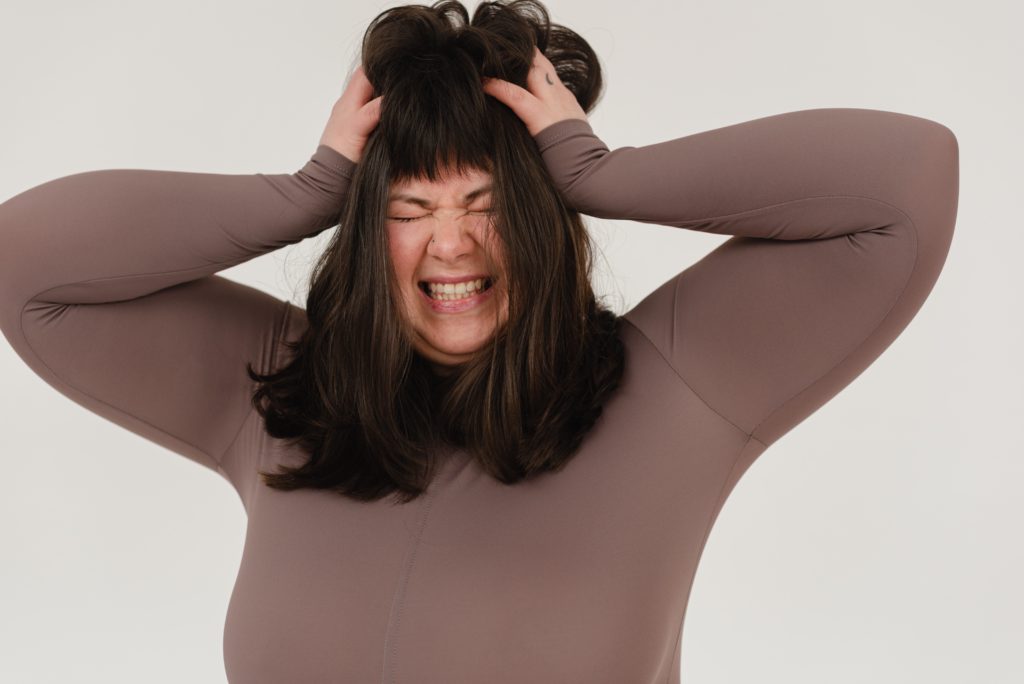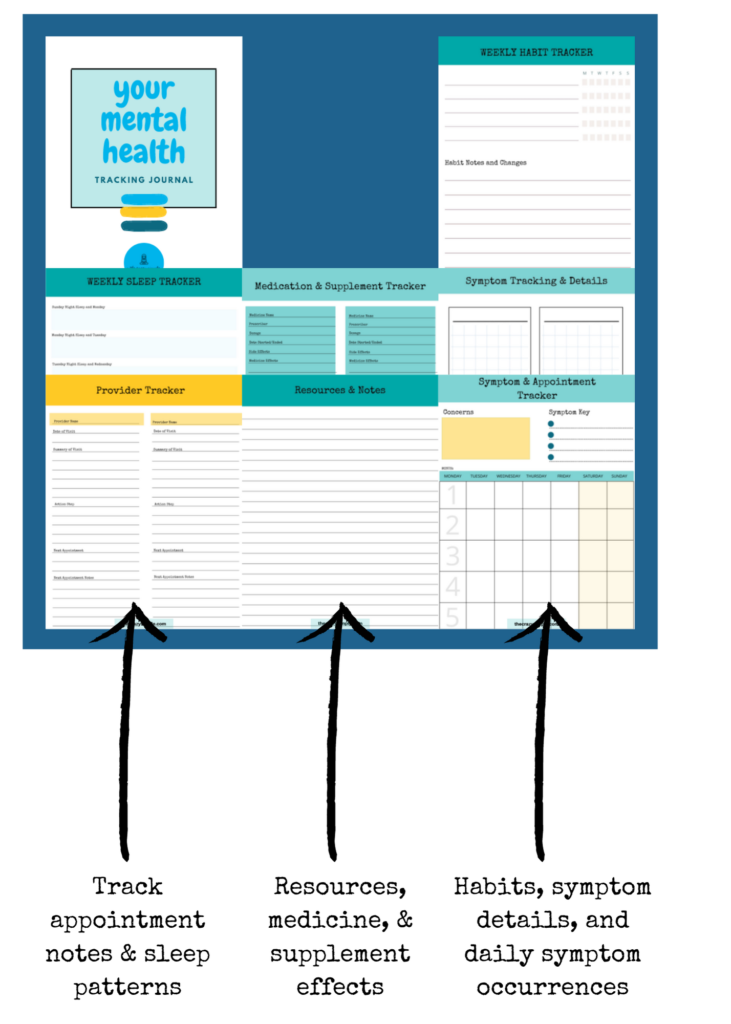I was lying in my daughter’s room the other night. She was having trouble sleeping so we were being quiet, still. It was dark and I was surrounded by quiet. This would usually be peaceful to me. Relaxing after all the kid, dog, clacking, neighborhood noises that make up my typical life soundtrack.
But this time, I wasn’t enjoying the quiet. My body was tense and my mind was unsettled–negative thoughts bouncing back and forth. Instead of feelings of lightness or joy, I felt heavy. I felt fear.
I could feel depression sitting right beside me in the dark, transforming the space from one of peace to one of dread.
Depression – my Old Nemesis
This wasn’t new. In fact, I cannot remember a February in almost 20 years where I didn’t deal with some level of depression.
Something about winter–seasonally linked perhaps, or maybe because February coincided with the anniversary of when I first became horribly sick with OCD and depression. Whatever it was, I used to dread winter and tried desperately to hang on until March rolled around and spring came forth like a victory band proclaiming the war was over.
Fortunately, being an unwilling student of depression for so long had eventually started to pay off years ago.
I hadn’t suffered the same crippling, in-the-closet-crying-cannot-function depression for many years. I chalk up this improvement to medicine, amazing therapy, a very supportive spouse, embracing mindfulness, and lots of learning and reading on my part.
But even when you feel as though you know how to manage depression well, the fear of it returning can still scare you to pieces.
That’s because clinical depression is one of the most painful, most difficult, most soul-sucking illnesses someone can face.

It robs you of your ability to see things as they are, your ability to feel any sense of aliveness or joy, your ability to connect, and even your ability to care about all the people and things you logically know are precious to you.
According the American Psychiatric Association, “Depression (major depressive disorder) is a common and serious medical illness that negatively affects how you feel, the way you think and how you act.”
According to me, depression causes a disconnect in what you know to be true and what you feel to be true. It causes a disconnect in who you are to the world and who you are to yourself. And, in the aftermath, you must build your life back up, like a home after a hurricane, piece-by-piece.

The Pause Before Reacting
So, that night lying in my daughter’s room, I felt fear but I also felt lucky. Lucky because I wasn’t facing this demon for the first, nor the 20th time. This time, finally, I knew what to do.
Breathe in and out.
I reminded myself that I had tools. I had knowledge. I wasn’t the same person I was at 19.
Breathe in and out.
My attention quickly honed in on my body. I could feel my muscles tensing up as though I was trying to harden myself so the depression couldn’t get in.
Breathe in and out.
I mindfully uncurled my fingers and focused on softening my shoulders, my stomach, my face. Keeping depression out wasn’t the answer.
Breathe in and out.

I knew that my instinct to shut out these strong emotions and fear would hurt me more than it would help me.
Breathe in and out.
I let the depression, the sadness, the yuckiness be. Like an annoying little brother who won’t leave you alone, I let it hang out with me.
Breathe in and out.
Both my body and mind wanted to shut down, turn away from the fear. But years of doing just that taught me that I wouldn’t be successful with this method. Shutting it out just makes it louder. Instead, I just let it be–the feelings, the anxiety, the unjoy and unfeeling.
Breathe in and out.
Accept that this ugh, this yuck, this disconnect probably wasn’t going to leave as quickly as I wanted. But, I had caught it before it sank me, and therefore I could keep it in check.
Breathe in and out.
I knew I had to allow the feelings and thoughts. At the same time I knew that I couldn’t follow the thoughts, couldn’t get sucked into the rabbit hole of what-if’s and should-haves and why didn’t you.
Thinking that way is a surefire way for depression to take hold and those thoughts and feelings were distortions. Instead, I had to acknowledge and accept the depression. For the time being.
Acknowledge and accept–a life mantra for me.
Accepting that this low-level depression was going to be around for a while–it was mid-February–didn’t excite me. But it didn’t surprise me, either.
Truthfully, this little guy had been lurking around lately. There were signs.
Depression Symptoms Creeping In
I had a hard time waking up in the morning and was going to bed early.
I realized that I wanted to sit in the corner of the couch, like I was attached to it by some invisible link.

Walking my dog–even just around the block–seemed like a lot of work.
And I didn’t have any interest in talking to friends and family; I had to force myself to send a text or make a call.
Yes, there had been signs.
Luckily I had mindfulness practices. And I knew how to use them to buffer me from this.
So I did. I have.
I accept that I feel blah right now.
I accept that sometimes I want to scream.

I accept that sometimes the negative feelings feel more pervasive than the positive ones.
I accept that I need to be aware of my self-talk so that depression doesn’t sneak in through that avenue.
I accept that I don’t want to do some things. I also accept that I still have to do them.
Hello, Friluftsliv
And then there was my new tool, friluftsliv. I had only read about it a few weeks prior but it spoke to my self-diagnosed couch sitting issue.
Friluftsliv is a Scandinavian philosophy that is much simpler and basic than the foreign term would have you believe. It means that people who friluftsliv make a point to spend time outside, regardless of the weather. They bundle up if need be (and it’s Scandinavia so, it’s need be!) and get outdoors.

Now, I cannot blame the weather for my desire to stay inside during the winter. Notwithstanding our crazy 2021 snow event, our winters are mild. We get tons of sunshine and you’ll often find people wearing shorts throughout the Christmas season into January.
But, for some reason, every year, my body seemed to go into a hibernation mode once October rolls around. So I figured I needed to force some friluftsliv on myself. As a bonus, the name made me feel like I was doing something much more exciting than simply going outside.

So I practice friluftsliv. Usually.
I play tennis at the local courts.
I take Lucky, my dog, for walks to the dog park or around the neighborhood.
I attempt to keep my body in one piece as I rollerblade to the park with my daughter.
Or, if going outside just doesn’t work, I try to jump on my yoga mat a few times to stretch and move my body. It’s not the same as being outside but movement–any movement – is good.
Managing Depression
Depression, clinical depression, is common. I didn’t know this when I first started wrestling with it in the 90’s but with the advent of the internet, I understand that I’m not alone when I experience deep, unrelenting depression. Knowing I’m not alone doesn’t take the sting out of an episode, but it does make me feel somewhat comforted, knowing that there are others in the same boat as me.
But I’m quick to point out that deep depression, clinical depression, probably won’t respond so easily to mindfulness and friluftsliv. You may need more help before these tools work.
I use these to help manage my moods along with other tools mentioned above. All these pieces together form my management strategy and so far it has helped me to avoid episodes of lasting depression like the ones I experienced in my past.

If you suffer from depression, consider actively managing it. If you haven’t tried mindfulness and friluftsliv, give them a go. Practice them when you are healthy and are functioning normally so that they are readily available when you feel depression at your own back.
Being aware that depression is hanging around is scary but it can also be a Godsend. If I become aware of it early enough, I can be diligent and use mindfulness and friluftsliv to prevent a deep slide into the abyss.
Keep track of your depression symptoms and resources below.






